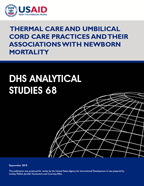
Abstract:
Although child mortality has decreased
considerably in the last several decades,
newborn mortality has declined less
substantially and its share of all under-5
mortality consequently has grown. While life-
saving interventions such as skilled birth
attendance and delivery in a health facility
have increased, they have only contributed to
a limited reduction in neonatal mortality.
This calls for further study on specific
interventions related to newborn care. This
study examines the associations of thermal
and cord care practices with newborn
mortality.
This study used data from 16 Demographic and
Health Surveys to examine changes over time
in coverage of recommended newborn care
practices—thermal care and hygienic cord care
—and differences in coverage of recommended
practices by place of delivery. Among home
births, we further examined the associations
between newborn care practices and newborn
mortality over time, and the key predictors
of receipt of the recommended practices.
Sample size proved to be a limitation to
exploring associations between recommended
newborn care practices and neonatal mortality
among home births within individual surveys.
Thus, we pooled data from recent surveys with
newborn care questions to test the
association between each practice and newborn
mortality within a larger sample. We also
conducted an in-depth analysis of newborn
care practices among home births in larger
and pooled samples in India, Bangladesh, and
Nepal. We performed multivariable logistic
regressions to test the associations between
newborn care practices and neonatal
mortality, and to explore predictors of
newborn care practices in these countries.
Overall, we found an increase in recommended
newborn care practices over time, more
implementation of practices among births
delivered in a health facility than at home,
and a relationship between cord care and
mortality among home births. In a pooled
sample of home births assessed in recent
surveys in Bangladesh and Nepal, we found
that newborns who had only an antiseptic
placed on their umbilical cord stump had
significantly lower odds of dying compared
with babies who had dry cord care. In recent
surveys in South Asia, we found that
antenatal care and skilled attendance at
birth significantly increased the odds of
receiving recommended newborn care practices.
However, missing responses were common for
mothers whose newborn died, particularly in
response to questions about the child’s first
bath. These results suggest a potential
mediating relationship of newborn care
practices between antenatal and delivery care
and newborn survival, and we suggest that
counseling on these interventions during
antenatal care might help to ensure that
women understand the recommended practices in
the event that they cannot access a health
facility to deliver. Findings also suggest
that a mother’s recall or report of details
surrounding the traumatic event of a loss of
a child may be incomplete.
 Thermal Care and Umbilical Cord Care Practices and Their Association with Newborn Mortality (PDF, 973K)
Thermal Care and Umbilical Cord Care Practices and Their Association with Newborn Mortality (PDF, 973K)
